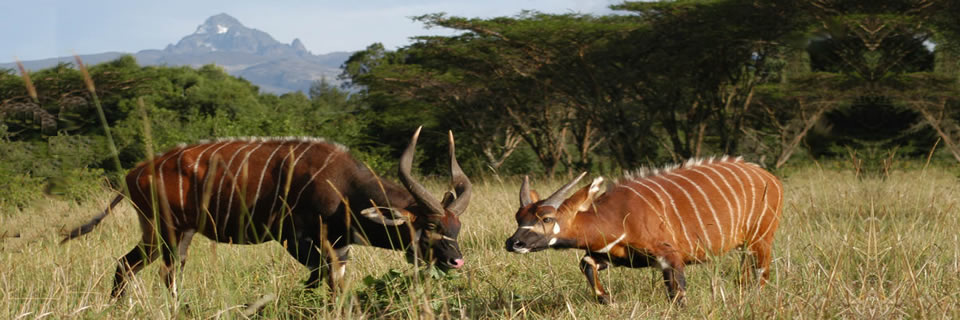
Mt Kenya
Mt Kenya is the highest mountain in Kenya and the second highest in Africa after Kilimanjaro. Mt Kenya is a broad volcanic cone whose base is around 120 km in diameter. The mountain was formed by volcanic eruption during the Great Rift Valley creation and geologists believe that it was over 1500m higher than its present height of 5199m (17,057ft).
At this stage it would have had a summit crater, however intensive erosion has worn away the original upper parts of the cone leaving arêtes, pyramidal peaks, U-shaped valleys and rock basins containing glacial lakes.
The peaks of Batian (5199m) and Nelion (5188m) are the remains of a huge volcanic plug that has slowly eroded to create the distinctive silhouette. Only 16 kms south of the Equator, the peaks are permanently iced with snow and glaciers. However, in the last 20 years, the glaciers have been retreating and it is estimated that if the present trend continues there may be no permanent ice left on the mountain.
Since records were established in 1893, eight of the eighteen glaciers then recorded have disappeared. On the lower slopes below 4000m, trekkers encounter a variety of alpine vegetation ranging from rain forest, bamboo, hagena and hypericum woodland, giant heather, tussock, and the fascinating giant lobelia.
The forests are rich in wildlife and elephant, buffalo, zebra, antelope and monkeys are often seen. Bird life everywhere is plentiful and varied. Mt Kenya (or Kirinyaga) was revered by the Gikuyu who settled in the Central Highlands and believed their god, Ngai, lived on top of the mountain.
The first European to lay eyes on the mountain was Ludwig Krapf, a Swiss missionary in 1849, but his stories of snow on the Equator were ridiculed by the Geographic Society in England. It was only in 1883 when a Scottish explorer, Joseph Thomson, confirmed its existence that Krapf’s findings were accepted.
Other explorers followed and several attempts to scale the mountain were made. In 1899, Halford MacKinder and two Alpine guides made the first successful ascent of the mountain and named the two highest peaks after Maasai leaders. Mt Kenya is unexpectedly different, attracting trekkers and mountaineers from all over the world. The mountains unique landscape and vegetation have been declared as International Biosphere Reserve by UNESCO. Its range of walking and climbing routes offers something for everyone and, unless your time is limited, is too good to miss.
It is certainly one of the most beautiful mountains anywhere!


